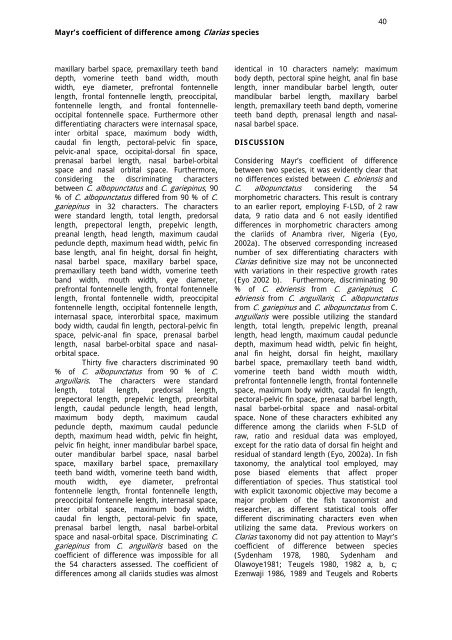Length-weight relationship of fishes from Anambra ... - Zoo-unn.org
Length-weight relationship of fishes from Anambra ... - Zoo-unn.org
Length-weight relationship of fishes from Anambra ... - Zoo-unn.org
- No tags were found...
You also want an ePaper? Increase the reach of your titles
YUMPU automatically turns print PDFs into web optimized ePapers that Google loves.
Mayr’s coefficient <strong>of</strong> difference among Clarias species40maxillary barbel space, premaxillary teeth banddepth, vomerine teeth band width, mouthwidth, eye diameter, prefrontal fontennellelength, frontal fontennelle length, preoccipital,fontennelle length, and frontal fontennelleoccipitalfontennelle space. Furthermore otherdifferentiating characters were internasal space,inter orbital space, maximum body width,caudal fin length, pectoral-pelvic fin space,pelvic-anal space, occipital-dorsal fin space,prenasal barbel length, nasal barbel-orbitalspace and nasal orbital space. Furthermore,considering the discriminating charactersbetween C. albopunctatus and C. gariepinus, 90% <strong>of</strong> C. albopunctatus differed <strong>from</strong> 90 % <strong>of</strong> C.gariepinus in 32 characters. The characterswere standard length, total length, predorsallength, prepectoral length, prepelvic length,preanal length, head length, maximum caudalpeduncle depth, maximum head width, pelvic finbase length, anal fin height, dorsal fin height,nasal barbel space, maxillary barbel space,premaxillary teeth band width, vomerine teethband width, mouth width, eye diameter,prefrontal fontennelle length, frontal fontennellelength, frontal fontennelle width, preoccipitalfontennelle length, occipital fontennelle length,internasal space, interorbital space, maximumbody width, caudal fin length, pectoral-pelvic finspace, pelvic-anal fin space, prenasal barbellength, nasal barbel-orbital space and nasalorbitalspace.Thirty five characters discriminated 90% <strong>of</strong> C. albopunctatus <strong>from</strong> 90 % <strong>of</strong> C.anguillaris. The characters were standardlength, total length, predorsal length,prepectoral length, prepelvic length, preorbitallength, caudal peduncle length, head length,maximum body depth, maximum caudalpeduncle depth, maximum caudal peduncledepth, maximum head width, pelvic fin height,pelvic fin height, inner mandibular barbel space,outer mandibular barbel space, nasal barbelspace, maxillary barbel space, premaxillaryteeth band width, vomerine teeth band width,mouth width, eye diameter, prefrontalfontennelle length, frontal fontennelle length,preoccipital fontennelle length, internasal space,inter orbital space, maximum body width,caudal fin length, pectoral-pelvic fin space,prenasal barbel length, nasal barbel-orbitalspace and nasal-orbital space. Discriminating C.gariepinus <strong>from</strong> C. anguillaris based on thecoefficient <strong>of</strong> difference was impossible for allthe 54 characters assessed. The coefficient <strong>of</strong>differences among all clariids studies was almostidentical in 10 characters namely: maximumbody depth, pectoral spine height, anal fin baselength, inner mandibular barbel length, outermandibular barbel length, maxillary barbellength, premaxillary teeth band depth, vomerineteeth band depth, prenasal length and nasalnasalbarbel space.DISCUSSIONConsidering Mayr’s coefficient <strong>of</strong> differencebetween two species, it was evidently clear thatno differences existed between C. ebriensis andC. albopunctatus considering the 54morphometric characters. This result is contraryto an earlier report, employing F-LSD, <strong>of</strong> 2 rawdata, 9 ratio data and 6 not easily identifieddifferences in morphometric characters amongthe clariids <strong>of</strong> <strong>Anambra</strong> river, Nigeria (Eyo,2002a). The observed corresponding increasednumber <strong>of</strong> sex differentiating characters withClarias definitive size may not be unconnectedwith variations in their respective growth rates(Eyo 2002 b). Furthermore, discriminating 90% <strong>of</strong> C . ebriensis <strong>from</strong> C. gariepinus; C.ebriensis <strong>from</strong> C. anguillaris; C . albopunctatus<strong>from</strong> C. gariepinus and C. albopunctatus <strong>from</strong> C.anguillaris were possible utilizing the standardlength, total length, prepelvic length, preanallength, head length, maximum caudal peduncledepth, maximum head width, pelvic fin height,anal fin height, dorsal fin height, maxillarybarbel space, premaxillary teeth band width,vomerine teeth band width mouth width,prefrontal fontennelle length, frontal fontennellespace, maximum body width, caudal fin length,pectoral-pelvic fin space, prenasal barbel length,nasal barbel-orbital space and nasal-orbitalspace. None <strong>of</strong> these characters exhibited anydifference among the clariids when F-SLD <strong>of</strong>raw, ratio and residual data was employed,except for the ratio data <strong>of</strong> dorsal fin height andresidual <strong>of</strong> standard length (Eyo, 2002a). In fishtaxonomy, the analytical tool employed, maypose biased elements that affect properdifferentiation <strong>of</strong> species. Thus statistical toolwith explicit taxonomic objective may become amajor problem <strong>of</strong> the fish taxonomist andresearcher, as different statistical tools <strong>of</strong>ferdifferent discriminating characters even whenutilizing the same data. Previous workers onClarias taxonomy did not pay attention to Mayr’scoefficient <strong>of</strong> difference between species(Sydenham 1978, 1980, Sydenham andOlawoye1981; Teugels 1980, 1982 a, b, c;Ezenwaji 1986, 1989 and Teugels and Roberts

















